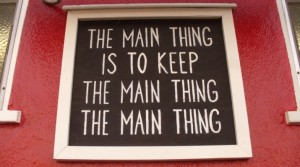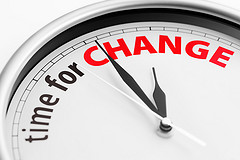A new year lends itself naturally to reflection and planning, leading for some to make resolutions. My reflections and resolutions revolved mainly around what to let go of and what to make room for – what’s “out” and what’s “in.” Of course organizations and their leaders need to make comparable decisions on a regular basis, often coinciding with yearly strategic planning and budgeting. Fundamentally, such decisions answer questions like these:
- What practices, processes and traditions still serve us well, and which do not?
- If there is a need to “lighten our load,” what criteria should we use for what to keep and what to jettison?
- What are our goals; what will we need to accomplish those goals? What will likely no longer be needed or may just drag us down?
- How should we organize to achieve our goals? (Personally, this could be as simple as reorganizing our office and files; organizations need to look at things like organizational structure, roles, systems and processes.)
- Whom should we associate with? Who shares our goals and values, and whom should we consider partnering with? Whom should we part with?
It dawned on me that some of the same framework that’s helpful making these decisions at a personal level is also relevant for organizations and their leaders:
First, reconnect with our foundation – at a personal level, that includes any mission, goals, values or principles. As Roy Disney said: “It’s easier to make decisions when we know what our values are.” It is valuable for organizations to do the same, especially when facing the likely need for significant change. “Form follows function,” so it’s a good idea to  be clear about our function or purpose at the outset as a basis for decisions that follow. For example, health care organizations of all stripes will continue experiencing significant turmoil in coming years as they merge, reorganize, seek greater efficiencies and otherwise adjust to their radically changing landscape. Sustainable change and engagement of caregivers that populate those organizations, however, will depend significantly on not losing site of their original mission and core values; as Steve Covey reminded us: “The main thing is to keep the main thing the main thing.” Change management initiatives commonly focus mainly on what to change; sustainable change management focuses at least equally on what should not change – chiefly our core purpose and values.
be clear about our function or purpose at the outset as a basis for decisions that follow. For example, health care organizations of all stripes will continue experiencing significant turmoil in coming years as they merge, reorganize, seek greater efficiencies and otherwise adjust to their radically changing landscape. Sustainable change and engagement of caregivers that populate those organizations, however, will depend significantly on not losing site of their original mission and core values; as Steve Covey reminded us: “The main thing is to keep the main thing the main thing.” Change management initiatives commonly focus mainly on what to change; sustainable change management focuses at least equally on what should not change – chiefly our core purpose and values.
Second, do not confuse core purpose with ways that we traditionally accomplished that purpose. Most of the physicians whom I’ve worked with are deeply committed to providing  the best care for their patients. However some are very resistant to modifying their own personal care-giving style, or to fully adopting electronic medical records. Yet common protocols and more accessible patient records across their whole care-giving institution would likely result in higher-quality care overall. The Polaroid camera folks couldn’t imagine “instant photography” any differently than via their initial proprietary technology; otherwise, they might still be achieving that mission by powering our smartphone cameras today. We all need to open our eyes and take our blinders off so we can imagine new and better ways to accomplish our aims; even if we don’t, our competitors will.
the best care for their patients. However some are very resistant to modifying their own personal care-giving style, or to fully adopting electronic medical records. Yet common protocols and more accessible patient records across their whole care-giving institution would likely result in higher-quality care overall. The Polaroid camera folks couldn’t imagine “instant photography” any differently than via their initial proprietary technology; otherwise, they might still be achieving that mission by powering our smartphone cameras today. We all need to open our eyes and take our blinders off so we can imagine new and better ways to accomplish our aims; even if we don’t, our competitors will.
Third, reflect on whom we want to undertake our journey with. In my own new year sorting-out process, I decided that life is too short to waste on people who don’t follow through, don’t return emails or calls and in general contribute to negative energy; it’s better to move on and focus on brighter prospects. Jim Collins (Built To Last and From Good to Great) was right when he said that “first we need to get the right people on the bus.” (I’m a sailor, though, so my version is “get the right people in the boat!”) Whether bus or boat, it’s good to occasionally take stock of where we’re headed, what will be required to make the journey, and if everyone is still up for it.
In addition to whom we make a journey with, we need to consider what resources will be required. I have to admit, this is a challenge for me. My bookshelves and files are bulging with books, articles, client files and materials that I think I might want “some day.” My resources are limited though, as are organizations’ resources; we have to decide what to keep, what to discard and where to reinvest. Here are a few questions that help:
What is still relevant? There are a few books lining my shelves that are as relevant today as when first published years ago; I’ll keep those. Many materials useful for clients in the past, as much work as went into them, simply won’t be useful again; the world has moved on. Organizations too can be burdened by traditions and practices that have lost their relevancy.
Is there another or better way? Altering our practices or introducing technology can lighten our loads. At a personal level we can scan older important documents or photos and store them electronically; likewise, we can replace many hardcover books with their electronic versions stored on our e-readers. Technology investments or reworked processes can also replace more costly work methods, and unfortunately some workers.
What is hardest to replace? It might be more efficient to discard some objects in our home or office, but for whatever reason they are part of what makes our home, home. Care should likewise be taken when considering who may no longer be needed in organizations. Are they part of what makes a community that community? Do they possess legacy skills, wisdom or contacts?
In case of fire . . . Of course we hope that it won’t come to pass, but if a fire broke out in our home or office, what’s at the top of our list to take? If we had to start out again in business tomorrow, what and whom would we need most?
If you’ve participated in any “Lost on the Moon,” “Lost at Sea” or related survival simulations, you probably remember that group consensus rankings usually score higher than individual rankings. ‘What’s in and what’s out” decisions at the organizational level aren’t democratic, but benefit from participation; others see things differently or see different things than we do, and that usually yields better decisions. As long as rules about how decisions will be made are clear up front and opinions are respected, participation buys more ownership of outcomes.
In my book Navigating Integrity . . ., I make a distinction between “alignment” the noun and “aligning” the verb. Alignment the noun suggests a kind of permanence, or fixedness;  there are some things like core purpose or principles that rarely if ever change, with which to align most everything else. Aligning the verb suggests movement and adaptation. The world is diverse and ever-changing; we can get as lost by not sufficiently adapting or flexing as we can by losing touch with our foundation. We will benefit by engaging in variations of this “out with the old, in with the new” process on a continual basis, and not just at the beginning of a new year.
there are some things like core purpose or principles that rarely if ever change, with which to align most everything else. Aligning the verb suggests movement and adaptation. The world is diverse and ever-changing; we can get as lost by not sufficiently adapting or flexing as we can by losing touch with our foundation. We will benefit by engaging in variations of this “out with the old, in with the new” process on a continual basis, and not just at the beginning of a new year.
What’s on your “out with the old” list? What habits, practices, materials or relationships no longer serve you well?
What’s on your “in with the new” list? What new disciplines, practices, resources or relationships will you adopt to move forward?
How might you and others in your circle engage in the practice of making sound decisions about “what’s out” and “what’s in” in a systematic way?
“A modern view of the processes of growth, decay and renewal must give due emphasis to both continuity and change in human institutions.”
John W. Gardner
“In matters of style, swim with the current; in matters of principle, stand like a rock.”
Thomas Jefferson

Cleaning house and tending to the important priorities is most likely something I should tend to on a more regular basis than I do, but your questions are good, Al. I would add that in looking at our priorities we should pay special attention to the big elephants in the room. You all know what I mean. There are some very difficult things that should have been addressed last year or maybe back in 2008. Hard things postponed just become more difficult. If I needed to change the people on the bus two years ago and they are still riding, I’m likely to be cleaning off shelves rather than tending to what might have a bigger impact on my business. Any suggestions for getting the unpleasant jobs to the top of the list and taking action? Lola Fredrickson
‘Good points, Lola. So really it’s not just “out with the old, in with the new;” we need to add: “and get on with unfinished business.” I guess the critical question with unfinished business is “Why haven’t we acted?” There’s either a good reason that we just need to acknowledge, or we need to exercise more courage and get on with it.” (Yeah, I know – ‘easier said than done!)
Al, Thanks for reminding me that I can’t just keep adding. I have to let go and make room in order to add, or better, exchange. Keeping the main thing the main thing and choosing wisely who to surround us with and who to collaborate with are two other key points I am happy you emphasize. They play a major role in being effective and balanced, in personal and professional life, small scale and large scale. In the past 10 years I have deliberately transferred people from the front row of my theater to the back row and vice versa. A wold of difference.
Thanks, Carolien. I’m happy that you’re in my “front row,” and ‘hope to be in yours!